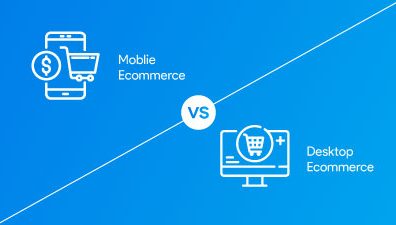Understanding the nuances between omnichannel vs unified commerce is crucial for businesses looking to stay ahead in the competitive retail market. While both strategies aim to enhance the customer experience, their approaches and implementations differ significantly. Businesses must carefully evaluate these differences to choose the strategy that best aligns with their goals, technological capabilities, and customer expectations. In this comprehensive guide, we will delve into the key distinctions between omnichannel and unified commerce, explore their respective benefits and challenges, and provide insights to help businesses make informed decisions about their retail strategies.
Table of Contents
Setting the Scene: Omnichannel vs Unified Commerce
Defining Omnichannel Commerce
Omnichannel commerce is a retail strategy that integrates all customer touchpoints—such as physical stores, online platforms, and mobile apps—to provide a seamless and consistent shopping experience across all channels. This approach ensures that customers can interact with the brand fluidly, with their preferences and behaviors recognized and carried over from one channel to another.
What is Omnichannel Commerce?
Omnichannel commerce is a retail strategy designed to create a seamless customer experience across multiple channels. Unlike traditional multichannel approaches, where each channel operates independently, omnichannel commerce integrates all customer touchpoints, including physical stores, eCommerce platforms, mobile apps, and social media. The goal is to provide a consistent and unified experience regardless of where or how a customer chooses to interact with the brand.
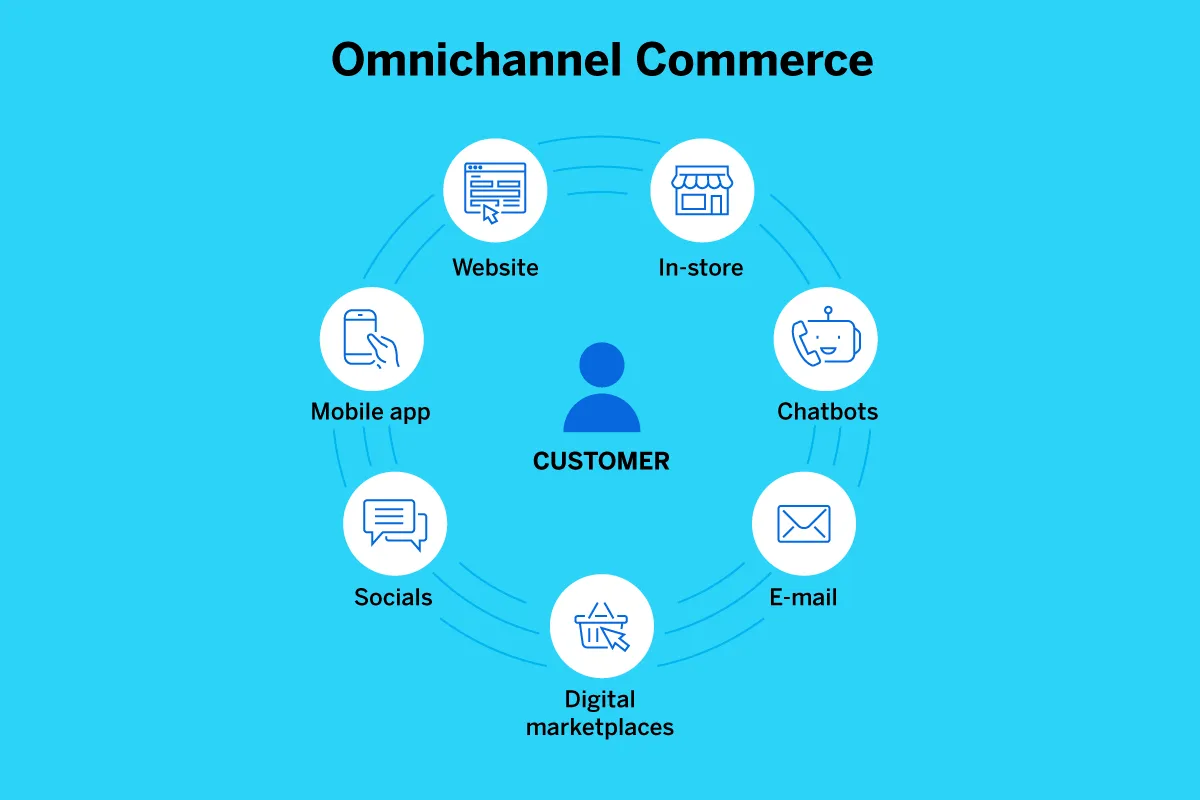
In an omnichannel environment, a customer might start their shopping journey by browsing products on a mobile app, add items to their cart on a desktop computer, and complete the purchase in a physical store. The omnichannel strategy ensures that the customer’s journey is fluid, with all interactions and preferences carried over from one channel to the next. This integration is achieved through sophisticated technology that connects disparate systems, enabling the sharing of customer data, inventory levels, and order history across all platforms.
Key Features of Omnichannel
Omnichannel commerce is characterized by several key features that distinguish it from other retail strategies:
- Channel Integration: The core of omnichannel commerce is the integration of all channels to create a cohesive customer experience. This integration ensures that customers receive consistent information and service across all touchpoints.
- Unified Customer Experience: Omnichannel strategies focus on delivering a seamless experience that transcends individual channels. Whether a customer is interacting with the brand online, in-store, or through a mobile app, the experience remains consistent.
- Personalization: Omnichannel commerce leverages customer data from various channels to deliver personalized experiences. This might include personalized product recommendations, targeted marketing messages, and customized promotions based on the customer’s preferences and behavior.
- Real-Time Inventory Management: Effective omnichannel strategies rely on real-time visibility into inventory levels across all channels. This ensures that customers can access accurate information about product availability, regardless of where they choose to shop.
- Cross-Channel Fulfillment: Omnichannel commerce supports various fulfillment options, such as buy online, pick up in-store (BOPIS), ship from store, and same-day delivery. This flexibility allows customers to choose the fulfillment method that best suits their needs.
- Consistent Branding: A successful omnichannel strategy ensures that the brand’s messaging, tone, and visual identity are consistent across all channels. This reinforces the brand’s identity and builds customer trust.
Benefits of Omnichannel Commerce
Omnichannel commerce offers numerous benefits for both retailers and customers, making it a popular choice for businesses looking to enhance their customer experience and drive sales.
- Enhanced Customer Satisfaction: By providing a seamless and consistent experience across all channels, omnichannel commerce meets the high expectations of modern consumers. Customers appreciate the convenience of being able to interact with the brand in multiple ways without encountering disruptions or inconsistencies.
- Increased Sales and Customer Loyalty: The personalized experiences enabled by omnichannel strategies can lead to higher conversion rates and increased customer loyalty. When customers feel valued and understood, they are more likely to make repeat purchases and become brand advocates.
- Comprehensive Customer Insights: Omnichannel commerce allows retailers to collect and analyze data from multiple sources, providing a 360-degree view of the customer. This wealth of information can be used to refine marketing strategies, improve product offerings, and create more targeted promotions.
- Greater Flexibility and Convenience: With cross-channel fulfillment options, customers can choose how they want to receive their purchases, whether it’s picking up an item in-store, having it delivered to their home, or even receiving it the same day. This flexibility enhances the overall shopping experience and can be a key differentiator in a competitive market.
- Improved Inventory Management: Real-time inventory tracking across all channels ensures that retailers can manage stock more effectively, reducing the risk of overstocking or stockouts. This not only improves operational efficiency but also enhances the customer experience by ensuring that popular products are always available.
- Strengthened Brand Consistency: By maintaining consistent branding across all channels, omnichannel commerce helps to reinforce brand identity and build trust with customers. Consistent messaging and visuals ensure that customers know what to expect, regardless of how they choose to engage with the brand.
Omnichannel commerce represents a significant advancement in retail strategy, offering numerous benefits that can enhance the customer experience, increase sales, and improve operational efficiency. However, it is important to understand that while omnichannel commerce focuses on integrating multiple channels, it still involves managing separate systems and processes for each channel. This distinction sets the stage for a deeper exploration of how unified commerce takes integration to the next level, providing a more streamlined and cohesive approach to retail management. The following sections will delve into unified commerce, highlighting its key features, benefits, and how it compares to omnichannel commerce.
Defining Unified Commerce
While omnichannel commerce focuses on providing a cohesive experience across various channels, unified commerce takes this integration to the next level by centralizing all aspects of the business into a single, unified platform. This section delves into the concept of unified commerce, exploring what it is, its key features, and the significant benefits it offers to modern retailers.
What is Unified Commerce?
Unified commerce is a retail strategy that integrates all customer interactions, sales channels, and business operations into one centralized platform. Unlike omnichannel commerce, where different channels may still operate with separate systems, unified commerce consolidates everything into a single, cohesive system. This approach ensures that every aspect of the business, from inventory management to customer service, is managed in real-time, providing a seamless and consistent experience across all touchpoints.
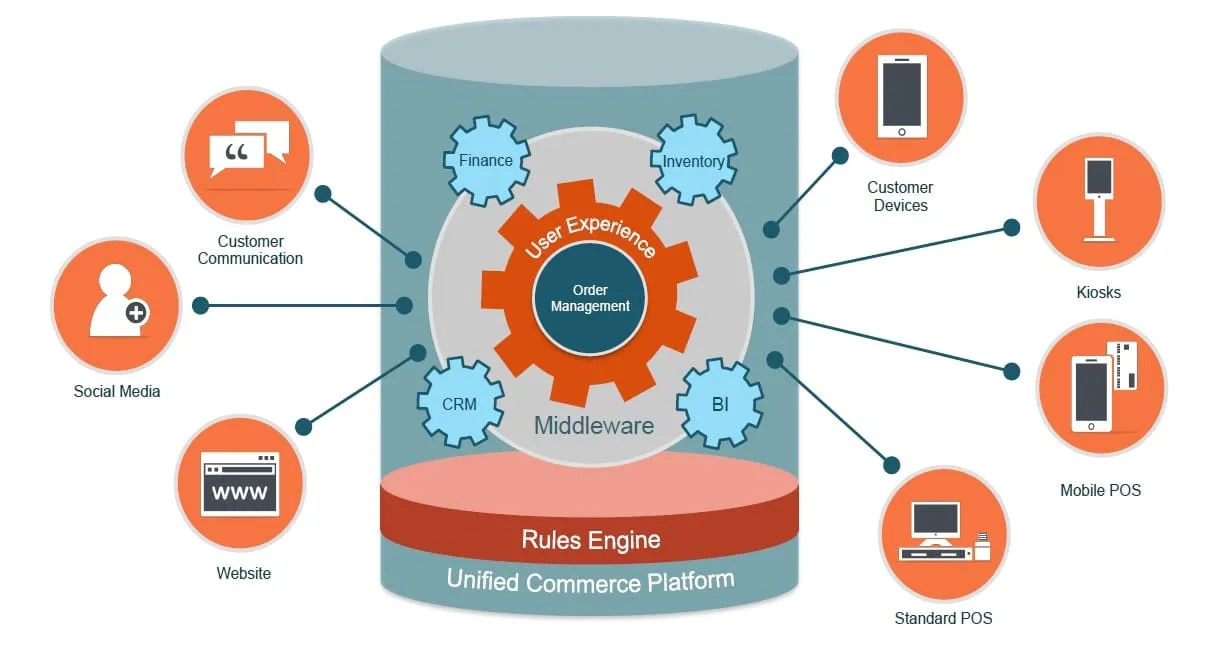
In essence, unified commerce eliminates the silos that often exist between different sales channels and operational systems. By unifying these elements, businesses can achieve greater efficiency and accuracy in their operations. For example, a customer who begins their shopping journey on a mobile app can seamlessly transition to completing their purchase in-store, with the same information and experience being carried over. This level of integration is made possible by a centralized system that continuously updates and synchronizes data across all channels, ensuring that every interaction is informed by the most current information.
Key Features of Unified Commerce
Unified commerce is characterized by several key features that distinguish it from other retail strategies, particularly in the context of omnichannel vs unified commerce:
- Centralized Platform: At the heart of unified commerce is a single platform that manages all aspects of the business. This centralization allows for the seamless integration of sales channels, customer data, inventory management, and order fulfillment. By eliminating the need for separate systems, businesses can reduce complexity and improve operational efficiency.
- Real-Time Data Synchronization: One of the most significant advantages of unified commerce is the ability to synchronize data in real-time across all channels. This means that inventory levels, customer interactions, and order statuses are always up-to-date, regardless of where the interaction takes place. This real-time synchronization ensures that customers receive accurate information at every touchpoint, leading to a more consistent and reliable shopping experience.
- Seamless Customer Experience: Unified commerce enables a truly seamless customer experience by ensuring that all interactions are connected and consistent. Whether a customer is browsing online, interacting with a chatbot, or visiting a physical store, their experience is unified and informed by the same data. This eliminates the frustration of disjointed experiences and builds stronger customer relationships.
- Single Source of Truth: With unified commerce, all business data is stored and managed within a single system, providing a unified view of the customer and the business. This single source of truth ensures that all departments—marketing, sales, customer service, and operations—are working from the same data set, leading to more informed decision-making and better collaboration across the organization.
- Scalability and Flexibility: Unified commerce platforms are designed to be scalable, allowing businesses to easily add new channels or expand operations without the need for significant reconfiguration. This flexibility is crucial for businesses that are growing or looking to adapt quickly to changing market conditions.
- Enhanced Security and Compliance: Centralizing operations within a unified platform also enhances security and compliance. Businesses can implement consistent security protocols across all channels and ensure that data protection measures are uniformly applied. This is particularly important in industries with stringent regulatory requirements.
Benefits of Unified Commerce
Unified commerce offers numerous benefits that make it an attractive strategy for modern retailers, particularly when compared to omnichannel commerce:
- Improved Operational Efficiency: By centralizing all aspects of the business into one platform, unified commerce significantly reduces the complexity of managing multiple systems. This simplification leads to improved operational efficiency, as businesses can streamline processes, reduce redundancies, and eliminate the need for manual data reconciliation.
- Enhanced Customer Experience: The real-time data synchronization and seamless customer journey enabled by unified commerce lead to a more satisfying and consistent customer experience. Customers appreciate the ability to interact with the brand across various channels without encountering disruptions or inconsistencies, leading to higher levels of customer satisfaction and loyalty.
- Increased Agility: Unified commerce allows businesses to be more agile in their operations. With a single platform managing all channels, businesses can quickly adapt to changes in customer behavior, market trends, or operational needs. This agility is crucial for staying competitive in a fast-paced retail environment.
- Better Decision-Making: The centralized data management provided by unified commerce gives businesses a comprehensive view of their operations and customers. This holistic perspective allows for more informed decision-making, as businesses can analyze data across all channels to identify trends, optimize processes, and develop targeted marketing strategies.
- Cost Savings: While the initial investment in a unified commerce platform may be significant, the long-term cost savings can be substantial. By reducing the need for multiple systems, minimizing manual processes, and improving efficiency, businesses can lower their operational costs and achieve a higher return on investment.
- Future-Proofing the Business: Unified commerce is designed to be scalable and flexible, making it easier for businesses to future-proof their operations. As new technologies and channels emerge, businesses can integrate them into the existing platform without the need for extensive reconfiguration, ensuring that they remain competitive in an ever-evolving market.
Unified commerce represents the next step in the evolution of retail strategies, offering a level of integration and efficiency that surpasses even the most advanced omnichannel implementations. By centralizing all aspects of the business into a single platform, unified commerce enables retailers to provide a truly seamless and consistent customer experience while optimizing their operations and decision-making processes. As the retail landscape continues to evolve, understanding the differences between omnichannel vs unified commerce will be key to choosing the right strategy for long-term success.
What Separates Omnichannel vs Unified Commerce
When examining the differences between omnichannel vs unified commerce, it’s essential to recognize that while both approaches aim to create a seamless customer experience, they achieve this goal through different means. Omnichannel commerce integrates various sales channels to provide a consistent experience across them, but it often does so by connecting disparate systems. Unified commerce, on the other hand, centralizes all systems and data into one platform, eliminating the silos that can complicate operations and lead to inconsistencies.
Aspect | Omnichannel Commerce | Unified Commerce |
System Integration and Data Management | Multiple systems are integrated but remain distinct, leading to potential data duplication and delays. | Centralizes all systems and data in one platform, ensuring real-time updates and seamless data flow. |
Customer Experience Consistency | Aims for consistent experiences, but discrepancies may occur due to separate systems. | Provides a fully consistent experience as all interactions are managed on a unified platform. |
Operational Efficiency and Agility | Managing multiple systems is complex, time-consuming, and limits agility. | Simplifies operations by consolidating into one platform, enabling faster adjustments and greater efficiency. |
System Integration and Data Management
One of the most significant factors separating omnichannel vs unified commerce is the level of integration between systems and how data is managed. In an omnichannel setup, each channel—whether it’s an online store, a physical location, or a mobile app—often operates on its own system. While these systems are connected to allow for shared data and coordinated customer experiences, they remain distinct entities. This can lead to issues such as data duplication, delays in information updates, and inconsistencies across channels.
Unified commerce addresses these challenges by bringing all systems and data under a single, unified platform. This centralization ensures that all customer interactions, inventory levels, and order statuses are updated in real-time across every channel. The result is a more cohesive operation where data flows seamlessly, providing a single source of truth for the entire business. This level of integration not only streamlines operations but also enhances the customer experience by ensuring that information is always accurate and up-to-date.
Customer Experience Consistency
Another critical difference between omnichannel vs unified commerce lies in the consistency of the customer experience. While omnichannel strategies strive to provide a uniform experience across various touchpoints, the reliance on multiple systems can sometimes lead to discrepancies. For example, a customer might receive different information about product availability depending on whether they are shopping online or in-store, simply because the systems aren’t perfectly synchronized.
In contrast, unified commerce ensures that the customer experience is truly consistent, regardless of how or where a customer engages with the brand. Because all interactions are managed through a single platform, customers receive the same information and service quality across every channel. This not only reduces the risk of confusion or frustration but also builds stronger customer loyalty, as shoppers come to trust that their experience will be the same whether they are browsing online, speaking with a customer service representative, or visiting a physical store.
Operational Efficiency and Agility
The operational differences between omnichannel vs unified commerce are also significant. In an omnichannel setup, managing multiple systems can be complex and resource-intensive. Businesses must invest in integrating these systems, maintaining them, and ensuring that they communicate effectively. This complexity can make it difficult to adapt quickly to changes in the market or customer behavior, as any adjustments need to be made across multiple platforms.
Unified commerce simplifies operations by consolidating everything into a single platform. This centralization not only reduces the complexity of managing the business but also makes it easier to implement changes quickly and efficiently. For example, if a business wants to introduce a new sales channel or update its pricing strategy, these changes can be implemented across the entire operation simultaneously, rather than requiring adjustments to each system individually. This agility is crucial in today’s fast-paced retail environment, where the ability to adapt quickly can be a key competitive advantage.
While omnichannel commerce has been a valuable strategy for enhancing customer experiences, unified commerce represents the future of retail. By fully integrating all channels and operations into a single platform, unified commerce offers superior data management, operational efficiency, scalability, and customer loyalty. As the retail landscape continues to evolve, businesses that embrace unified commerce will be better equipped to thrive in a competitive market, ensuring their long-term success in the ever-changing world of retail.
Omnichannel vs Unified Commerce: A Detailed Comparison
Focus
When comparing omnichannel vs unified commerce, one of the most critical aspects to consider is the focus of each strategy. Both approaches aim to enhance the customer experience and streamline business operations, but they differ significantly in how they achieve these goals. Omnichannel commerce emphasizes the integration of various channels to create a cohesive and consistent customer experience across all touchpoints.
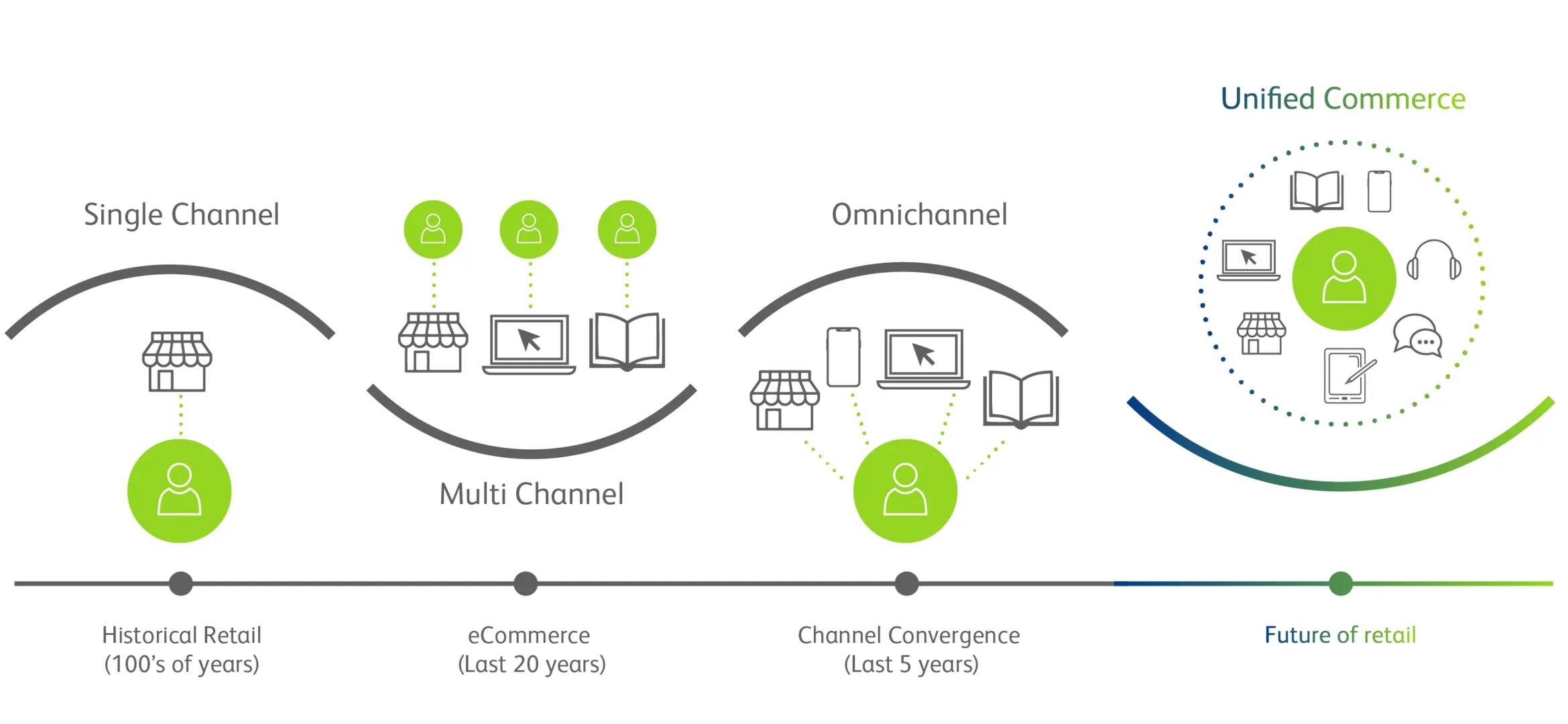
In contrast, unified commerce takes this concept further by focusing on the integration of all systems and channels into a single platform, ensuring a seamless experience not just for customers, but across the entire business operation. Understanding this distinction in focus is key to determining which approach is best suited for your business needs.
Omnichannel Commerce
At its core, omnichannel commerce is about ensuring that customers have a consistent and coherent experience across all touchpoints, whether they are shopping online, in-store, or through a mobile app. The primary focus of omnichannel commerce is on integrating various sales and communication channels so that they work together harmoniously. This integration is designed to create a unified customer experience, where interactions on one channel can seamlessly continue on another.
For example, a customer might begin their shopping journey by researching products on a retailer’s website, add items to their cart via a mobile app, and finally complete the purchase in a physical store. In an omnichannel system, all these touchpoints are synchronized, allowing the customer to move effortlessly between channels without losing any information or encountering inconsistencies. The customer’s preferences, shopping history, and any interactions with customer service are all accessible across channels, ensuring that the experience remains coherent and uninterrupted.
However, while omnichannel commerce excels at channel integration, it often does so by connecting separate systems. Each channel—such as the online store, physical retail locations, and customer service operations—may still operate on its own platform, with integration occurring at the surface level. This approach can create challenges in terms of data management and operational efficiency, as different systems must constantly communicate and synchronize with one another to maintain consistency. Despite these challenges, the focus on channel integration has made omnichannel commerce a powerful strategy for delivering a cohesive customer experience across multiple platforms.
Unified Commerce
Unified commerce takes the principles of omnichannel commerce a step further by shifting the focus from merely integrating channels to fully integrating all systems and channels into a single, centralized platform. This approach addresses many of the limitations associated with omnichannel strategies by eliminating the need for multiple, often disconnected, systems. Instead of simply connecting different channels, unified commerce consolidates all business operations—sales, inventory management, customer service, order fulfillment, and more—into one cohesive system.
The result is a truly seamless experience not only for customers but also for the business itself. In a unified commerce model, every aspect of the operation is managed through a single platform, ensuring that data flows smoothly and consistently across all channels. Whether a customer is interacting with the brand online, in-store, or through a mobile app, their experience is informed by the same real-time data. This level of integration ensures that information is always accurate and up-to-date, reducing the risk of inconsistencies and errors that can occur when multiple systems are in play.
From an operational standpoint, the focus on integrating all systems into a single platform provides significant advantages. Businesses can streamline processes, reduce redundancies, and improve efficiency by managing everything from a centralized system. For example, inventory levels are updated in real-time across all channels, ensuring that stock availability is always accurate, regardless of where the customer is shopping. Similarly, customer interactions and purchase histories are recorded in a single database, allowing for more personalized and informed customer service.
Moreover, the unified commerce approach enables businesses to be more agile and responsive to changes in the market or customer behavior. Since all systems are connected and managed through one platform, businesses can implement changes more quickly and efficiently than in an omnichannel setup, where adjustments must be made across multiple systems. This agility is crucial in today’s fast-paced retail environment, where the ability to adapt to new trends and customer demands can be a key competitive advantage.
Approach
In the ongoing debate of omnichannel vs unified commerce, understanding the different approaches these strategies take is crucial for businesses looking to optimize their retail operations and enhance customer experiences.

Both omnichannel and unified commerce aim to create a seamless journey for customers, but they employ distinct methods to achieve this goal. This section will explore the approach each strategy takes, highlighting the unique ways in which they deliver a cohesive and satisfying experience for consumers.
Omnichannel Commerce
The approach of omnichannel commerce is centered around providing a consistent and unified customer experience across all available channels. Whether a customer interacts with a brand through an online store, a mobile app, a physical retail location, or even social media, the experience should be coherent and harmonious. The primary goal is to ensure that each touchpoint is integrated with the others, creating a seamless journey that allows customers to move effortlessly from one channel to another without encountering disruptions or inconsistencies.
To achieve this, omnichannel commerce relies on connecting multiple systems that manage different channels. These systems are integrated to share data, allowing businesses to synchronize information such as customer preferences, purchase histories, and inventory levels across all platforms. For instance, a customer might start browsing products on a retailer’s website, add items to their cart via a mobile app, and finally make a purchase in-store. Throughout this process, the omnichannel strategy ensures that the customer’s journey remains smooth, with each channel reflecting the same information and offering a cohesive experience.
This harmonization is key to the success of omnichannel commerce. It allows businesses to deliver personalized and contextually relevant interactions, no matter how or where customers choose to engage. However, the challenge lies in maintaining this consistency across multiple, often disparate, systems. Each channel might operate on its own platform, and while these platforms are integrated, they still function independently. This can lead to potential delays in data synchronization, discrepancies in inventory information, or variations in customer service across channels.
Despite these challenges, omnichannel commerce has proven to be a powerful strategy for retailers. By focusing on harmonizing the customer experience across all touchpoints, it allows businesses to build stronger relationships with their customers, enhance brand loyalty, and drive sales across multiple platforms. However, as retail environments become more complex and customer expectations continue to rise, the limitations of this approach have become more apparent, leading to the emergence of a more integrated solution: unified commerce.
Unified Commerce
Unified commerce represents an evolution in retail strategy, addressing many of the challenges associated with the omnichannel approach. While omnichannel commerce focuses on integrating multiple systems to create a consistent customer experience, unified commerce goes further by centralizing the management of all inventory, orders, and customer data into a single, cohesive platform. This centralized approach not only enhances the customer experience but also streamlines business operations, making it easier for retailers to manage their entire operation from one place.
The key advantage of unified commerce lies in its ability to provide real-time data and insights across all channels. In a unified commerce system, every aspect of the business—from inventory levels to order processing and customer interactions—is managed through a single platform. This eliminates the need for separate systems to communicate with each other, reducing the risk of data discrepancies, delays, and inconsistencies. For example, when a customer makes a purchase online, the inventory is immediately updated across all channels, ensuring that stock levels are accurate in real-time. Similarly, customer data, such as purchase history and preferences, is instantly accessible across all touchpoints, allowing for more personalized and timely interactions.
This centralized management not only improves the efficiency of retail operations but also enhances the overall customer experience. With unified commerce, customers can expect a seamless and consistent experience, whether they are shopping online, in-store, or through a mobile app. The real-time synchronization of data ensures that they receive accurate information at every touchpoint, reducing the likelihood of frustration caused by out-of-stock items, delayed orders, or inconsistent service.
Moreover, the unified approach allows businesses to be more agile and responsive to changes in customer behavior or market conditions. Since all operations are managed from a single platform, businesses can quickly implement changes across the entire organization, whether it’s adjusting pricing, updating promotions, or launching new products. This agility is crucial in today’s fast-paced retail environment, where the ability to adapt quickly can provide a significant competitive advantage.
Goal
Both omnichannel vs unified commerce aim to enhance the customer experience and optimize business operations, but they do so with different end objectives in mind.

This section will delve into the specific goals of each approach, highlighting how omnichannel commerce focuses on synchronizing channels for a seamless customer journey, while unified commerce strives to centralize all operations and interactions to provide a singular, cohesive view of the customer and the business.
Omnichannel Commerce
The primary goal of omnichannel commerce is to provide a seamless and integrated customer journey by ensuring that all channels are synchronized and working together. In an omnichannel strategy, the focus is on creating a unified experience for the customer across various touchpoints—whether they are shopping online, visiting a physical store, engaging with a mobile app, or interacting through social media. The objective is to eliminate any friction or barriers between these channels so that customers can move effortlessly from one to another without experiencing any disruptions or inconsistencies.
To achieve this goal, businesses employing an omnichannel approach work diligently to integrate their various sales and communication channels. This integration allows for the synchronization of customer data, inventory information, and order statuses across all platforms. For instance, a customer might start their shopping journey by researching products on a brand’s website, then use a mobile app to check store availability, and finally complete the purchase in a physical store. Throughout this process, the omnichannel strategy ensures that the customer’s interactions are connected and coherent, with each channel reflecting the same up-to-date information.
This synchronized approach not only enhances the customer experience but also supports businesses in building stronger relationships with their customers. By offering a consistent and frictionless journey, brands can increase customer satisfaction, loyalty, and ultimately, sales. However, achieving this level of synchronization can be challenging, especially when dealing with multiple systems that must communicate and share data in real-time. Despite these challenges, the goal of creating a seamless customer journey remains at the heart of omnichannel commerce, making it a powerful strategy for businesses looking to connect with customers across various platforms.
Unified Commerce
While omnichannel commerce focuses on synchronizing channels to enhance the customer journey, the goal of unified commerce is to create a singular, integrated view of both the customer and the business, where all interactions and operations are managed under one cohesive platform. Unified commerce takes the concept of integration a step further by consolidating all systems, processes, and data into a single, centralized platform. This centralization allows businesses to manage every aspect of their operations—from inventory and order management to customer service and marketing—through one unified system.
The goal of unified commerce is to provide a seamless and real-time experience that benefits both the customer and the business. For the customer, this means that all interactions with the brand are consistent and informed by the same data, regardless of the channel they choose to use. Whether they are shopping online, visiting a physical store, or interacting with customer support, their experience is unified and coherent, with no discrepancies or delays in information. For the business, this centralized approach allows for greater efficiency, accuracy, and agility in managing operations.
By striving to create a singular view of the customer and the business, unified commerce enables brands to gain deeper insights into customer behavior, preferences, and trends. This comprehensive understanding allows businesses to deliver more personalized and relevant experiences, which can drive higher levels of customer engagement and loyalty. Additionally, the unified platform provides businesses with real-time visibility into their operations, enabling them to make more informed decisions, optimize processes, and respond quickly to changes in the market or customer demand.
The goal of unified commerce is not just to enhance the customer journey but to revolutionize the way businesses operate by breaking down silos and creating a truly integrated system. This approach ensures that all data is centralized, all channels are connected, and all operations are streamlined, resulting in a more cohesive and efficient business model. As the retail landscape continues to evolve, the goal of unified commerce—to provide a singular, holistic view of the entire business—positions it as a forward-thinking strategy that is well-equipped to meet the demands of modern consumers and complex market conditions.
Customer Experience
In the omnichannel vs unified commerce debate, one of the most critical areas where these two strategies diverge is the customer experience. Both approaches strive to create a seamless, engaging, and cohesive journey for customers, but the methods they use—and the overall customer experience they deliver—vary significantly.
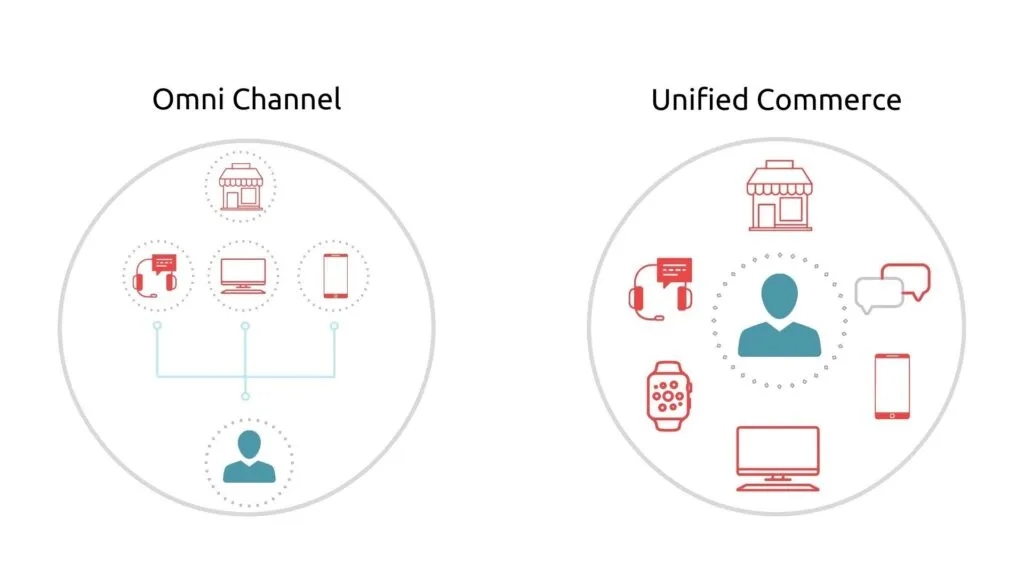
While omnichannel focuses on integrating multiple channels to provide a consistent experience, unified commerce takes it further by centralizing all operations and data into a single platform. This distinction leads to noticeable differences in how customers interact with the brand, receive information, and experience service quality across various touchpoints.
Omnichannel Commerce
The omnichannel commerce approach focuses on providing a consistent and integrated customer experience across multiple channels. The primary goal is to ensure that customers can interact with a brand seamlessly, whether they are shopping online, in a physical store, or through a mobile app. In an omnichannel strategy, each channel is interconnected, allowing customers to move effortlessly from one touchpoint to another while retaining access to their shopping history, preferences, and cart contents.
For example, a customer might begin their shopping journey by browsing products on a retailer’s website. Later, they might use the brand’s mobile app to check inventory at a nearby store, and finally, visit that store to make their purchase. Throughout this journey, the customer’s experience is synchronized, with each channel reflecting the same up-to-date information. This interconnectedness is made possible by integrating the various systems that manage each channel, ensuring that data is shared and updated in real-time.
The strength of omnichannel commerce lies in its ability to create a coherent and unified customer experience across diverse platforms. By integrating channels, businesses can provide personalized and contextually relevant interactions, making it easier for customers to engage with the brand in the way that suits them best. For instance, a customer might receive a promotional email, browse the recommended products on the website, and then use an in-store coupon they received via the brand’s app—all while enjoying a consistent and cohesive experience.
However, one of the challenges of omnichannel commerce is maintaining this level of synchronization across multiple, often disparate, systems. Each channel might operate on its own platform, and while these platforms are connected, they are still separate entities. This can lead to potential delays in data synchronization, discrepancies in customer information, or inconsistencies in service across channels. Despite these challenges, the omnichannel approach remains highly effective for businesses looking to provide a comprehensive and unified customer experience across multiple touchpoints.
Unified Commerce
Unified commerce takes the principles of omnichannel commerce and builds upon them by focusing on centralizing all customer interactions and business operations into a single, cohesive platform. The goal of unified commerce is to provide a seamless and real-time experience that is consistent across all channels, not just through surface-level integration, but by managing everything under one roof.
In a unified commerce system, every aspect of the customer experience—from browsing and shopping to order fulfillment and customer service—is managed through one centralized platform. This centralization ensures that all customer data, inventory levels, and transaction histories are accessible and up-to-date in real-time, no matter where or how the customer chooses to engage with the brand. For example, if a customer places an order online, their purchase history is immediately updated across all channels, allowing them to seamlessly return or exchange the item in-store, or track their order through the brand’s mobile app.
The key advantage of unified commerce in enhancing the customer experience is its ability to eliminate the silos that can exist in an omnichannel system. By consolidating all operations into a single platform, unified commerce ensures that the customer experience is not just synchronized but fully integrated. This means that customers receive consistent, accurate, and up-to-date information at every touchpoint, reducing the likelihood of frustration caused by out-of-stock items, delayed orders, or inconsistent service.
Moreover, unified commerce allows businesses to offer more personalized and timely interactions. Since all customer data is stored in one place, brands can leverage this information to deliver highly targeted promotions, personalized product recommendations, and customer service. For example, a customer who frequently purchases a particular product category can receive personalized offers or reminders based on their past behavior, regardless of whether they are shopping online or in-store. This level of personalization is made possible by the real-time data accessibility that unified commerce provides, allowing businesses to react quickly to customer needs and preferences.
Another significant benefit of unified commerce in terms of customer experience is the seamlessness it brings to cross-channel interactions. In an omnichannel system, while channels are integrated, there can still be gaps in the customer experience due to the separate systems managing each channel. Unified commerce removes these gaps by ensuring that all customer interactions are managed within a single platform. This results in a truly frictionless experience where customers can switch between channels—such as starting a purchase online and completing it in-store—without any disruption or loss of information.
Unified commerce also enhances the post-purchase experience, an area where many retailers struggle. With all data centralized, customers can easily manage returns, exchanges, or order tracking through any channel, with the assurance that their information is consistent across the board. For instance, a customer can initiate a return through an online portal and drop off the item at a physical location, with the system updating their return status in real-time. This not only improves customer satisfaction but also builds trust and loyalty by providing a reliable and transparent service.
Channel Integration
Understanding the nuances of channel integration in omnichannel and unified commerce can help businesses determine which approach is best suited to their operational needs and customer expectations.

This section explores how each strategy approaches channel integration, highlighting the strengths and limitations of both.
Omnichannel Commerce
In the omnichannel commerce model, the integration of channels is a central focus, with the goal of creating a cohesive customer experience across all platforms. However, this integration often occurs at a surface level, where each channel—such as physical stores, online shops, mobile apps, and social media—operates as a separate entity with its own system. These systems are connected, allowing them to share data and synchronize certain aspects of the customer journey, but they still function independently.
For instance, in an omnichannel setup, a retailer might have a separate inventory management system for their online store and their physical locations. While these systems are integrated to allow for shared data, such as stock levels and customer orders, they remain distinct. This means that when a customer purchases an item online, the inventory is adjusted in the online system and then communicated to the in-store system to reflect the change. However, because these systems are separate, there can be delays in synchronization, leading to potential discrepancies in available stock information between the channels.
This separation of systems in omnichannel commerce can lead to challenges, particularly in maintaining consistency and real-time accuracy across all channels. For example, a customer might add an item to their cart online, only to find that the item is no longer available when they try to purchase it in-store, due to delays in inventory updates between the systems. Additionally, managing multiple systems can create operational complexities, as each system may require its own maintenance, updates, and troubleshooting, making the overall management of the business more cumbersome.
Despite these challenges, omnichannel commerce remains a powerful approach for businesses seeking to provide a connected experience across various customer touchpoints. The ability to integrate different channels, even at a surface level, allows retailers to offer services like buy online, pick up in-store (BOPIS), and enables customers to engage with the brand in multiple ways. However, the inherent limitations of integrating separate systems highlight the need for a more advanced approach, which is where unified commerce comes into play.
Unified Commerce
Unified commerce represents an evolution in channel integration by merging all channels and systems into a single, fully integrated platform. Unlike the omnichannel approach, where channels operate as separate entities with interconnected systems, unified commerce consolidates everything into one cohesive system that functions as a single entity. This deep integration eliminates the silos that exist in omnichannel setups, ensuring that all customer interactions and business operations are managed through a unified platform.
In a unified commerce model, all channels—whether online, in-store, mobile, or social—are not just connected but are part of the same system. This means that every aspect of the business, from inventory management to order processing and customer data, is centralized and accessible in real-time across all touchpoints. For example, when a customer makes a purchase online, the inventory is immediately updated across all channels, ensuring that the information is accurate and consistent no matter where the customer chooses to shop.
This level of integration provides several key advantages over the traditional omnichannel approach. First, it ensures real-time synchronization of data across all channels, eliminating the risk of discrepancies or delays that can occur when systems operate independently. Customers benefit from a consistent and reliable experience, as they can trust that the information they receive is up-to-date and accurate, whether they are browsing online, shopping in-store, or interacting through a mobile app.
Second, unified commerce simplifies the management of business operations by consolidating all systems into one platform. This centralization reduces the complexity of maintaining multiple systems and ensures that updates, maintenance, and troubleshooting are streamlined. For businesses, this means greater efficiency and less time spent managing disparate systems, allowing them to focus more on delivering a superior customer experience.
Furthermore, the deep integration of unified commerce enables more personalized and responsive customer interactions. Since all customer data is stored and managed in one place, businesses can leverage this information to create highly targeted marketing campaigns, offer personalized product recommendations, and provide consistent service across all channels. This level of personalization is difficult to achieve in an omnichannel setup, where customer data might be fragmented across different systems.
Technology
Both omnichannel and unified commerce rely heavily on technological infrastructure to deliver seamless customer experiences and efficient business operations.

However, the way technology is employed in each strategy differs significantly, with profound implications for how businesses manage their operations and interact with customers.
Omnichannel Commerce
Omnichannel commerce has been a game-changer in the retail industry by allowing businesses to create a connected experience across multiple channels. The technology behind omnichannel commerce is designed to integrate various sales and communication channels—such as physical stores, eCommerce platforms, mobile apps, and social media—so that customers can enjoy a cohesive journey, regardless of how they choose to engage with the brand. However, despite these advancements, the technology underpinning omnichannel commerce often involves using separate systems for each channel, which can lead to potential fragmentation in operations.
In an omnichannel setup, different channels may be supported by distinct systems that handle specific functions such as inventory management, order processing, customer relationship management (CRM), and point of sale (POS). While these systems are integrated to communicate with one another and share data, they often operate independently. For instance, a retailer might use one system to manage its online store and another for its physical locations. These systems are connected via integration tools or middleware, enabling them to synchronize data like inventory levels, customer orders, and transaction histories.
However, this reliance on separate systems can lead to fragmentation in operations. Each system may have its own database, user interface, and operational protocols, which can create challenges in maintaining consistency and real-time accuracy across channels. For example, if there is a delay in data synchronization between the online store and the physical POS system, a customer might find that an item they purchased online is out of stock when they go to pick it up in-store. Such inconsistencies can lead to customer dissatisfaction and complicate inventory management, as different systems may not always reflect the same information at the same time.
Moreover, managing multiple systems can be complex and resource-intensive. Each system requires its own maintenance, updates, and troubleshooting, which can increase the operational burden on the business. Additionally, the integration of these systems often requires custom development and continuous monitoring to ensure that data flows smoothly between them. This complexity can make it difficult for businesses to scale their operations or quickly adapt to changes in customer behavior or market conditions.
Despite these challenges, the technology behind omnichannel commerce has enabled retailers to connect with customers in more meaningful ways, offering a level of flexibility and convenience that was previously unattainable. However, as retail environments become increasingly complex and customer expectations continue to rise, the limitations of this fragmented approach have led to the emergence of unified commerce as a more advanced and efficient solution.
Unified Commerce
Unified commerce represents the next evolution in retail technology by addressing the fragmentation issues associated with omnichannel commerce. Instead of relying on separate systems for each channel, unified commerce utilizes a centralized platform that integrates various systems and processes into a single, cohesive solution. This approach ensures seamless operation across all channels, providing businesses with a more streamlined and efficient way to manage their operations and deliver a consistent customer experience.
At the heart of unified commerce is a single, integrated platform that supports all aspects of the business, from inventory management and order processing to customer data and analytics. This platform serves as the central hub for all channels, ensuring that every interaction, transaction, and piece of data is managed within one system. For example, when a customer makes a purchase online, the order is processed, inventory is updated, and customer data is recorded—all within the same platform. This real-time synchronization eliminates the risk of data discrepancies and ensures that information is consistent and accurate across all channels.
The use of a centralized platform in unified commerce offers several key advantages over the traditional omnichannel approach. First and foremost, it simplifies operations by reducing the need to manage multiple systems. With everything integrated into one platform, businesses can streamline their processes, reduce operational overhead, and minimize the risk of errors. For instance, there is no need for complex integrations or middleware to connect disparate systems, as all functions are managed within the same environment.
Additionally, the centralized nature of unified commerce allows for greater flexibility and scalability. As businesses grow or as new technologies and channels emerge, they can easily expand their operations without the need for extensive reconfiguration. The unified platform can support additional channels, integrate new tools, and adapt to changing customer demands, all while maintaining a consistent and seamless experience across the board.
Another significant benefit of unified commerce technology is its ability to provide comprehensive insights and analytics. Since all data is consolidated within a single platform, businesses can gain a holistic view of their operations and customer behavior. This centralized data management enables more effective decision-making, as businesses can analyze trends, monitor performance, and optimize their strategies based on real-time information. For example, a retailer can track customer interactions across all channels, identify patterns in purchasing behavior, and tailor marketing efforts to better meet customer needs.
Furthermore, unified commerce enhances the customer experience by ensuring that all interactions are consistent, personalized, and responsive. With all customer data managed in one place, businesses can offer targeted promotions, personalized product recommendations, and seamless service across all touchpoints. This level of personalization and consistency is difficult to achieve in an omnichannel setup, where customer data may be fragmented across different systems.
Data Management
The way data is handled in omnichannel vs unified commerce strategies reveals a fundamental difference in their approaches.

While both aim to leverage data to improve customer interactions and streamline operations, they do so through distinct methods of data management.
Omnichannel Commerce
In an omnichannel commerce environment, data management is characterized by a distributed data system. This means that data is stored and managed across multiple, often disparate, systems that correspond to different channels or business functions. For example, a retailer might have separate databases for their eCommerce platform, physical stores, mobile app, and customer service operations. Each of these systems operates independently, and while they are connected to enable the sharing of data, they still function as distinct entities.
The distributed nature of data management in omnichannel commerce can lead to several challenges. One of the primary issues is the potential for data fragmentation. Since each channel or system maintains its own database, the same customer might have multiple profiles scattered across different systems. For instance, a customer who shops online and in-store might have separate records in the eCommerce database and the point-of-sale (POS) system. This fragmentation can make it difficult to get a comprehensive view of the customer, leading to inconsistencies in how they are served across different channels.
Additionally, the distributed data system in omnichannel commerce often results in delays in data synchronization. When a customer makes a purchase or interacts with a brand, the information needs to be communicated across various systems to ensure that all channels are updated. However, because these systems are separate, there can be lag times in the transmission of data. For example, if a customer returns an item purchased online at a physical store, the inventory and customer data may not be updated in real-time across all channels, leading to discrepancies in stock levels or order histories.
Another significant challenge of distributed data systems is the complexity of managing and maintaining them. Each system requires its own set of processes, tools, and resources for data management, making it resource-intensive and potentially error-prone. The need for constant integration and synchronization between systems adds to this complexity, as businesses must ensure that data flows smoothly and consistently across all platforms.
Despite these challenges, omnichannel commerce has been successful in allowing businesses to connect with customers across multiple touchpoints. The distributed data system, while not without its limitations, has enabled retailers to create a cohesive experience by integrating separate channels. However, as retail operations become more complex and customer expectations rise, the need for a more streamlined and efficient approach to data management has given rise to unified commerce.
Unified Commerce
Unified commerce addresses the limitations of distributed data systems by employing a centralized data system. In a unified commerce model, all data—whether it pertains to customers, inventory, orders, or sales—is stored and managed within a single, centralized platform. This centralization eliminates the silos that exist in omnichannel commerce, ensuring that all data is consolidated and accessible in real-time across all channels and business functions.
The centralized data system of unified commerce offers several key advantages over the distributed approach. First and foremost, it provides a single source of truth for the entire business. With all data housed in one platform, businesses can achieve a comprehensive and unified view of their customers, operations, and performance metrics. This holistic perspective allows for more accurate and informed decision-making, as businesses can analyze data from all channels without the risk of fragmentation or inconsistency.
For example, when a customer interacts with a brand through multiple channels—such as browsing products online, making a purchase in-store, and contacting customer service—their data is captured and updated in real-time within the centralized system. This ensures that every interaction is informed by the most current and complete information, leading to a more personalized and responsive customer experience. Unlike the distributed system of omnichannel commerce, where data might be scattered across different systems, unified commerce ensures that all data is synchronized and consistent, regardless of where the customer engages with the brand.
Moreover, the centralized data system in unified commerce simplifies data management by reducing the complexity of maintaining multiple systems. Since all data is managed within a single platform, businesses can streamline their processes and reduce the operational overhead associated with integrating and synchronizing separate systems. This not only improves efficiency but also minimizes the risk of errors and data discrepancies, as there is no need to reconcile information from different sources.
Another significant benefit of centralized data management in unified commerce is the ability to leverage real-time data insights. With all data being updated in real-time, businesses can respond more quickly to changes in customer behavior, market trends, or inventory levels. For instance, if a product is selling rapidly in one location, the centralized system can immediately adjust inventory across all channels to prevent stockouts, ensuring that customers always have access to the products they want. This level of agility is difficult to achieve with a distributed data system, where delays in data synchronization can lead to missed opportunities or inefficiencies.
In addition, the centralized data system in unified commerce enhances the ability to deliver personalized and consistent customer experiences. Since all customer data is stored in one place, businesses can use this information to create tailored marketing campaigns, recommend products based on past purchases, and provide consistent service across all channels. This level of personalization is crucial in today’s competitive retail environment, where customers expect brands to understand and anticipate their needs.
Scalability
Both omnichannel and unified commerce provide paths to scalability, but in different ways. Omnichannel integrates multiple systems across channels, which can become complex as businesses grow. Unified commerce centralizes all operations into a single platform, making it easier to scale efficiently.

Understanding the scalability differences between omnichannel vs unified commerce is crucial for businesses looking to grow while maintaining operational efficiency and delivering a seamless customer experience.
Omnichannel Commerce
Omnichannel commerce has gained widespread adoption in part due to its flexibility in accommodating new channels and technologies as they emerge. In an omnichannel strategy, businesses can integrate additional touchpoints—such as new social media platforms, mobile apps, or third-party marketplaces—into their existing infrastructure. This adaptability is one of the key advantages of omnichannel commerce, allowing businesses to stay current with technological advancements and evolving consumer behaviors.
When a business decides to introduce a new channel, the omnichannel model provides the flexibility to add this channel into the existing ecosystem. For example, a retailer might start by selling products through a brick-and-mortar store and an eCommerce website. As the business grows, it could easily integrate additional channels such as a mobile app, a presence on social media platforms, or partnerships with online marketplaces like Amazon or eBay. Each of these channels can be connected to the existing systems, enabling the business to expand its reach without overhauling its entire infrastructure.
However, the flexibility offered by omnichannel commerce comes with certain limitations, particularly as the business scales. As more channels and technologies are added, the complexity of managing them increases. Each new channel may require its own system or integration process, which can lead to a more fragmented operational environment. This fragmentation can create challenges in maintaining consistency and efficiency across the business, as data from different channels must be synchronized and managed across multiple systems.
Moreover, as the number of channels increases, so does the need for integration tools and middleware to ensure that these channels can communicate effectively with one another. This can lead to higher operational costs and more resource-intensive management processes. For instance, a business might need to invest in additional software, development resources, and IT support to keep all systems integrated and functioning smoothly. Over time, this can create a bottleneck in scalability, as the growing complexity of the infrastructure makes it more difficult to maintain seamless operations.
Despite these challenges, omnichannel commerce remains a powerful strategy for businesses looking to expand their presence across multiple touchpoints. Its flexibility allows businesses to respond quickly to changes in the market and adopt new technologies, making it an attractive option for those who prioritize adaptability. However, the scalability of omnichannel commerce is often limited by the need to manage a growing number of separate systems, which can hinder operational efficiency and create challenges as the business continues to grow.
Unified Commerce
Unified commerce addresses the scalability challenges of omnichannel commerce by offering a more integrated and streamlined approach to managing growth. In a unified commerce model, all channels, systems, and processes are consolidated into a single, centralized platform. This centralization not only simplifies the management of the business but also makes it easier to scale operations as the business grows.
One of the key advantages of unified commerce is its ability to handle the complexity of an integrated environment while maintaining smooth and efficient operations. Because all aspects of the business are managed through one platform, adding new channels or technologies is a more straightforward process. Instead of needing to integrate a new channel with multiple existing systems, businesses can simply extend the capabilities of the unified platform to accommodate the new touchpoint. This reduces the complexity and cost associated with scaling, as there is no need for additional integration tools or middleware.
For example, if a retailer using a unified commerce platform decides to launch a new mobile app, the app can be seamlessly integrated into the existing system. All customer data, inventory information, and order processing workflows are already centralized, so the new channel can immediately access and share the same data in real-time. This ensures that the customer experience remains consistent across all channels, even as the business expands its reach.
Moreover, unified commerce platforms are designed to be inherently scalable, meaning they can grow alongside the business without requiring significant reconfiguration or additional infrastructure. Whether a business is adding new locations, expanding into new markets, or adopting new technologies, the unified platform can support these changes with minimal disruption. This scalability is crucial for businesses that anticipate rapid growth or that operate in dynamic markets where flexibility and responsiveness are essential.
Another significant benefit of unified commerce in terms of scalability is its ability to maintain operational efficiency as the business grows. Because all systems and processes are integrated into a single platform, businesses can avoid the fragmentation and inefficiencies that often accompany the expansion of omnichannel operations. This ensures that as the business scales, it can continue to deliver a seamless and consistent customer experience across all touchpoints, without the need for complex and resource-intensive management processes.
Summary
This table summarizes the key differences between omnichannel and unified commerce, providing a clear comparison across various aspects of each strategy.
Aspect | Omnichannel Commerce | Unified Commerce |
Focus | Emphasis on channel integration to create a coherent customer experience across all channels. | Focus on integrating all systems and channels into a single platform, providing a seamless experience across the entire business operation. |
Approach | Focuses on integrating multiple channels to provide a consistent customer experience across various touchpoints. | Centralizes all systems and channels into a single platform, ensuring a seamless experience across the entire operation. |
Goal | Aims to synchronize channels to create a seamless customer journey. | Strives to create a singular view of the customer and business, managing all interactions under one roof. |
Customer Experience | Provides a consistent experience across channels, though data may be fragmented across systems. | Offers a fully integrated experience with real-time data synchronization, enhancing personalization and consistency. |
Channel Integration | Channels are integrated but often operate as separate entities with their own systems, leading to fragmentation. | All channels and systems are fully merged into a single platform, providing a cohesive and unified experience. |
Technology | May involve using separate systems for each channel, potentially leading to fragmentation and operational complexity. | Utilizes a centralized platform that integrates various systems and processes, ensuring seamless operation. |
Data Management | Employs a distributed data system, where data is stored and managed across multiple, often disparate systems. | Uses a centralized data system, consolidating all information into one platform for real-time synchronization and consistency. |
Scalability | Offers flexibility to accommodate new channels and technologies, but may become complex and fragmented as it scales. | Scalable to handle the complexity of an integrated environment, ensuring smooth operations as the business grows. |
Case Studies: Real-World Examples
Examining real-world examples is essential for understanding the practical applications and outcomes of different retail strategies. In the debate between omnichannel vs unified commerce, looking at successful implementations of these strategies provides valuable insights into their effectiveness and the challenges they may present.
Omnichannel Case Study: Sephora
Sephora is a global leader in the beauty industry, known for its wide range of products, innovative retail strategies, and commitment to providing a personalized and engaging customer experience. Founded in 1969 in Limoges, France, by Dominique Mandonnaud, Sephora began as a small perfumery shop that offered an open-sell environment—a revolutionary concept at the time. This approach allowed customers to explore and test products freely, without the pressure of a sales-driven environment, setting the stage for Sephora’s future success as a trailblazer in the beauty retail space.

In 1997, Sephora was acquired by the luxury conglomerate LVMH (Moët Hennessy Louis Vuitton), which propelled the brand onto the global stage. Under LVMH’s ownership, Sephora rapidly expanded its footprint, opening stores across Europe, North America, Asia, and the Middle East. Today, Sephora operates over 2,600 stores in 35 countries, with a strong presence in both physical retail and eCommerce.
Sephora’s product offerings span a wide range of categories, including skincare, makeup, fragrance, hair care, and beauty tools. The company is renowned for its curated selection of both high-end luxury brands and emerging, independent labels, catering to a diverse customer base. Sephora’s product range is complemented by its own private label, Sephora Collection, which offers high-quality beauty products at accessible price points.
How Sephora Successfully Implemented Omnichannel Strategies
Sephora has long been recognized as a pioneer in the beauty industry, not just for its wide range of products but also for its innovative approach to retail. As consumer behaviors began to shift towards a more digital and interconnected shopping experience, Sephora quickly recognized the need to adapt its retail strategy to stay ahead of the competition. The company embarked on a comprehensive omnichannel journey, aiming to create a seamless and personalized experience for its customers across all touchpoints.
One of the key elements of Sephora’s omnichannel strategy is the seamless integration of its online and offline channels. Recognizing that customers often use multiple channels during their shopping journey—researching products online, seeking advice in-store, and purchasing through a mobile app—Sephora set out to ensure that these channels were not only connected but harmonized. This was achieved through the implementation of several innovative tools and technologies.
- Seamless Mobile Integration: Sephora understood early on the importance of mobile in the customer journey. The Sephora mobile app was designed to be more than just a shopping tool; it became a comprehensive platform for product discovery, education, and personalization. The app includes features such as the Virtual Artist, which allows customers to try on products virtually using augmented reality (AR), and the Beauty Bag, which syncs across all platforms, ensuring that customers’ favorite products, shopping carts, and wish lists are accessible whether they’re on the app, website, or in-store.
- In-Store Digital Experiences: Sephora’s stores are equipped with digital tools that bridge the gap between online and offline shopping. For instance, the Sephora Digital Makeover Guide provides customers with a personalized in-store experience by allowing them to scan products and receive tailored recommendations based on their preferences and purchase history. Additionally, in-store iPads and tablets enable customers to access online reviews, tutorials, and product information, enhancing the in-store shopping experience with the wealth of digital resources available online.
- Click-and-Collect Services: Another critical component of Sephora’s omnichannel strategy is the click-and-collect service, which allows customers to order products online and pick them up in-store. This service caters to customers who want the convenience of online shopping combined with the immediacy of in-store pickup. By integrating inventory systems across all channels, Sephora ensures that customers have a seamless experience, with real-time visibility of product availability and efficient order processing.
- Personalized Marketing: Sephora leverages its omnichannel capabilities to deliver highly personalized marketing messages. By collecting and analyzing customer data from various touchpoints—such as purchase history, online browsing behavior, and in-store interactions—Sephora can tailor its marketing efforts to individual customers. This personalization extends to product recommendations, targeted promotions, and loyalty program rewards, all designed to enhance customer engagement and drive sales.
- Loyalty Program Integration: The Sephora Beauty Insider program is a prime example of how the company has successfully integrated its loyalty program across all channels. Whether shopping online, in-store, or through the app, customers earn points for their purchases, which they can redeem for exclusive rewards. The program also provides personalized offers and early access to new products, encouraging customers to engage with the brand across multiple platforms.
Results and Lessons Learned
Sephora’s omnichannel strategy has yielded impressive results, both in terms of customer satisfaction and business performance. The company’s ability to integrate and harmonize its online and offline channels has not only enhanced the customer experience but also driven significant growth in sales and brand loyalty.
- Increased Customer Engagement: The seamless integration of channels and personalized experiences have led to higher levels of customer engagement. Sephora’s customers are more likely to interact with the brand across multiple platforms, whether it’s using the mobile app for virtual try-ons, visiting a physical store for a digital makeover, or participating in the Beauty Insider loyalty program. This increased engagement has translated into higher conversion rates and repeat purchases, as customers appreciate the convenience and personalization that Sephora’s omnichannel approach offers.
- Growth in Online Sales: Sephora’s commitment to integrating its digital and physical channels has driven substantial growth in online sales. The click-and-collect service, in particular, has been a significant contributor to this growth, as it appeals to customers who prefer the convenience of online shopping with the immediacy of in-store pickup. Additionally, the mobile app’s features, such as personalized product recommendations and virtual try-ons, have encouraged more customers to make purchases online, boosting eCommerce revenue.
- Enhanced Customer Loyalty: The omnichannel integration of Sephora’s Beauty Insider loyalty program has played a crucial role in enhancing customer loyalty. By offering personalized rewards and exclusive offers across all channels, Sephora has created a more engaging and rewarding experience for its customers. This has led to increased loyalty program participation, with members showing a higher lifetime value compared to non-members. The ability to earn and redeem points seamlessly across all platforms has also contributed to stronger brand loyalty.
- Operational Efficiency: While the omnichannel approach requires sophisticated technology and data management, Sephora has successfully navigated these challenges to create a more efficient and agile operation. The integration of inventory systems and customer data across all channels has allowed Sephora to optimize its supply chain, reduce stockouts, and improve order fulfillment times. This operational efficiency has not only enhanced the customer experience but also contributed to cost savings and improved profitability.
- Lessons Learned: Sephora’s journey in implementing omnichannel strategies offers valuable lessons for other retailers. First, the importance of investing in technology cannot be overstated. Sephora’s success is largely due to its ability to leverage advanced digital tools and platforms to create a seamless and personalized customer experience. Second, the integration of online and offline channels must be carefully managed to ensure consistency and real-time synchronization. Finally, personalization is key to driving customer engagement and loyalty. By using data effectively, Sephora has been able to tailor its marketing efforts and create a more meaningful connection with its customers.
Sephora’s omnichannel strategy exemplifies the power of integrating multiple channels to create a cohesive and engaging customer experience. The company’s ability to harmonize its online and offline platforms, personalize customer interactions, and optimize operations has positioned it as a leader in the beauty industry. For businesses considering the merits of omnichannel vs unified commerce, Sephora’s success demonstrates the potential of a well-executed omnichannel approach, while also highlighting the importance of technology, integration, and personalization in achieving retail excellence.
Unified Commerce Case Study: Nike
Nike, Inc. is one of the world’s largest and most influential brands in the athletic apparel, footwear, and sports equipment industry. Founded in 1964 as Blue Ribbon Sports by Bill Bowerman and Phil Knight, the company officially became Nike, Inc. in 1971, named after the Greek goddess of victory. Over the decades, Nike has become synonymous with innovation, performance, and style, cementing its place as a global leader in the sportswear market.

Nike’s success is built on its commitment to creating products that enhance athletic performance while also resonating with a broad audience of consumers, from professional athletes to casual fitness enthusiasts. The company’s product portfolio includes footwear, apparel, equipment, and accessories across various sports categories, such as running, basketball, soccer, and more. Nike is also known for its iconic brand partnerships, endorsements by top athletes, and groundbreaking advertising campaigns that have made its Swoosh logo and Just Do It slogan globally recognized symbols of athletic excellence.
As a forward-thinking company, Nike has always been quick to adapt to changes in consumer behavior and technological advancements. In the early 2000s, Nike embraced eCommerce and began building an omnichannel presence, integrating its online and offline channels to provide a more cohesive customer experience. However, as the retail landscape evolved and customer expectations grew, Nike recognized the need for a more integrated and seamless approach to managing its global operations and customer interactions. This realization led to Nike’s transition from an omnichannel strategy to a unified commerce model.
How Nike Transitioned from Omnichannel to Unified Commerce
Nike’s shift from omnichannel to unified commerce was driven by the need to create a more streamlined and efficient operation that could keep pace with the rapidly changing demands of the global market. The company’s omnichannel strategy had been successful in connecting its online and offline channels, but it also highlighted some challenges, particularly in managing data consistency, inventory accuracy, and customer experience across multiple systems.
Nike recognized that to maintain its competitive edge, it needed to move beyond the traditional omnichannel approach and adopt a unified commerce model that would centralize all aspects of its business operations. This meant integrating its eCommerce platform, physical stores, supply chain, and customer service into a single, cohesive system that could operate in real-time and provide a seamless experience for customers worldwide.
- Centralizing Data and Operations: One of the first steps Nike took in transitioning to unified commerce was to centralize its data and operations into a single platform. This involved integrating its various systems, including inventory management, order processing, customer relationship management (CRM), and point of sale (POS), into one unified platform. By doing so, Nike was able to eliminate data silos and ensure that all customer interactions, whether online or in-store, were informed by the same real-time data.
- Enhanced Inventory Management: Nike’s move to unified commerce significantly improved its inventory management capabilities. With a centralized platform, Nike could achieve real-time visibility into inventory levels across all channels and locations. This allowed the company to optimize stock levels, reduce overstock and stockouts, and ensure that customers had access to the products they wanted, regardless of where they were shopping. The unified system also enabled Nike to implement advanced fulfillment options, such as ship-from-store and buy online, pick up in-store (BOPIS), further enhancing the customer experience.
- Personalized Customer Experience: A key component of Nike’s unified commerce strategy was its focus on personalization. By consolidating customer data into a single platform, Nike was able to gain a comprehensive view of each customer’s preferences, purchase history, and behavior. This enabled the company to deliver highly personalized marketing messages, product recommendations, and loyalty rewards, tailored to individual customers across all touchpoints. Whether a customer was browsing online, shopping in a Nike store, or interacting with the Nike app, they received a consistent and personalized experience that strengthened their connection to the brand.
- Seamless Omnichannel Integration: While transitioning to unified commerce, Nike ensured that its various channels remained seamlessly integrated. This included the unification of its digital and physical retail experiences, where customers could start their shopping journey online and complete it in-store, or vice versa. The unified platform allowed for consistent customer experiences, with features like unified cart functionality, where customers could add items to their cart on the website and purchase them later through the app or in-store. This level of integration provided flexibility and convenience, making it easier for customers to engage with the brand on their terms.
- Investing in Technology and Innovation: Nike’s transition to unified commerce was supported by significant investments in technology and innovation. The company leveraged advanced data analytics, artificial intelligence (AI), and machine learning to enhance its operational capabilities and customer insights. Nike also developed and deployed its own proprietary technologies, such as the Nike Fit app, which uses AI to provide personalized shoe sizing recommendations, further enhancing the customer experience and reducing return rates.
Benefits Achieved and Challenges Faced
Nike’s transition to unified commerce has yielded numerous benefits, positioning the company as a leader in the global retail industry. However, the journey was not without its challenges. Here’s an overview of the benefits Nike achieved and the obstacles it encountered along the way.
Benefits Achieved:
- Improved Operational Efficiency: By centralizing its operations into a unified platform, Nike significantly improved its operational efficiency. The elimination of data silos and the real-time synchronization of information across all channels allowed Nike to streamline its processes, reduce redundancies, and optimize its supply chain. This efficiency translated into faster order fulfillment, better inventory management, and reduced operational costs, all of which contributed to enhanced profitability.
- Enhanced Customer Experience: Nike’s unified commerce strategy enabled the company to deliver a more consistent, personalized, and seamless customer experience. The centralized platform allowed for better customer insights and more effective personalization, leading to higher customer satisfaction and loyalty. The ability to offer advanced fulfillment options, such as BOPIS and ship-from-store, further enhanced the customer experience by providing greater convenience and flexibility.
- Increased Agility and Scalability: The unified commerce platform provided Nike with the agility to quickly adapt to changes in the market and customer behavior. Whether launching new products, expanding into new markets, or responding to global events like the COVID-19 pandemic, Nike was able to scale its operations efficiently without compromising the customer experience. This agility allowed Nike to maintain its competitive edge and continue growing in a dynamic retail environment.
- Data-Driven Decision Making: With a centralized data system, Nike gained a holistic view of its business operations and customer interactions. This comprehensive data enabled the company to make more informed decisions, optimize its marketing strategies, and improve its product offerings. The ability to analyze data in real-time also allowed Nike to identify trends and opportunities, driving innovation and enhancing its overall business performance.
Challenges Faced:
- Complexity of Implementation: Transitioning from an omnichannel model to unified commerce was a complex and resource-intensive process. Integrating multiple systems into a single platform required significant investment in technology, infrastructure, and talent. Nike had to carefully manage the transition to avoid disruptions to its operations and ensure that all channels remained functional during the integration process.
- Change Management: Implementing unified commerce required a cultural shift within the organization. Employees across different departments needed to adapt to new systems, processes, and ways of working. Nike invested heavily in training and change management initiatives to ensure that its workforce could effectively navigate the transition and fully leverage the benefits of the unified platform.
- Maintaining Consistency Across Global Markets: As a global brand, Nike operates in diverse markets with varying consumer behaviors, regulatory requirements, and logistical challenges. Implementing a unified commerce model across all these markets required careful coordination and customization to ensure that the platform could accommodate local needs while maintaining a consistent global experience.
Nike’s transition from omnichannel to unified commerce has been a transformative journey that has significantly enhanced the company’s ability to deliver a seamless and personalized customer experience. By centralizing its operations into a unified platform, Nike has achieved greater operational efficiency, improved customer satisfaction, and increased agility in responding to market changes. While the transition presented challenges, the benefits have positioned Nike as a leader in the retail industry, showcasing the potential of unified commerce as the future of retail. For businesses considering the shift from omnichannel vs unified commerce, Nike’s experience offers valuable insights into the advantages and considerations of adopting a unified approach.
Comparative Analysis
The transition from omnichannel to unified commerce is a significant evolution in the retail landscape, one that reflects the growing complexity and expectations of the modern consumer. By examining real-world examples such as Sephora’s omnichannel success and Nike’s transition to unified commerce, we can gain valuable insights into the practical applications of these strategies. This section provides a comparative analysis of these case studies, highlighting the key takeaways for other businesses considering the shift from omnichannel vs unified commerce.
Side-by-Side Comparison of the Case Studies
1. Approach and Strategy:
- Sephora (Omnichannel Commerce): Sephora’s approach centered on integrating multiple channels to create a seamless and consistent customer experience. The company successfully linked its online store, mobile app, and physical retail locations, allowing customers to interact with the brand across various touchpoints. The emphasis was on harmonizing these channels to ensure that customers received a coherent experience, regardless of where or how they engaged with Sephora.
- Nike (Unified Commerce): Nike’s transition from omnichannel to unified commerce involved moving beyond simple channel integration to a more holistic and centralized approach. By consolidating all systems and operations into a single platform, Nike achieved real-time synchronization and a unified view of the customer across all channels. This strategy allowed Nike to streamline operations and provide a more personalized and consistent customer experience on a global scale.
2. Technology Integration:
- Sephora (Omnichannel Commerce): Sephora employed a variety of digital tools and platforms to enhance the customer experience. The company’s mobile app, in-store digital tools, and eCommerce platform were integrated to share data and provide a cohesive experience. However, these systems often operated independently, leading to potential challenges in maintaining data consistency and real-time accuracy across all channels.
- Nike (Unified Commerce): Nike’s unified commerce strategy relied on a centralized technology platform that integrated all aspects of the business, from inventory management to customer data. This centralization allowed Nike to eliminate data silos, ensure real-time data synchronization, and simplify the management of its global operations. The result was a more efficient and agile business model that could quickly adapt to changes in the market.
3. Customer Experience:
- Sephora (Omnichannel Commerce): Sephora’s omnichannel strategy focused on providing a consistent and personalized customer experience across all touchpoints. The integration of digital tools, personalized marketing, and loyalty program features allowed Sephora to engage customers in a meaningful way. However, the reliance on separate systems sometimes led to challenges in maintaining a truly seamless experience, particularly as the number of channels grew.
- Nike (Unified Commerce): Nike’s unified commerce approach took customer experience to the next level by ensuring that all interactions were informed by the same real-time data. This allowed Nike to offer a fully integrated and personalized experience across all channels, with features like unified cart functionality and advanced fulfillment options. The centralized platform enabled Nike to deliver consistent service and personalization on a global scale, enhancing customer loyalty and satisfaction.
4. Scalability and Flexibility:
- Sephora (Omnichannel Commerce): While Sephora’s omnichannel strategy allowed for the addition of new channels and technologies, it also introduced complexity as the business scaled. Each new channel required integration with existing systems, which could lead to fragmentation and operational challenges. Sephora’s approach was flexible, but the reliance on multiple systems made scaling more resource-intensive.
- Nike (Unified Commerce): Nike’s unified commerce model was designed to be inherently scalable, allowing the company to expand its operations without the need for extensive reconfiguration. The centralized platform could easily accommodate new channels, technologies, and markets, ensuring smooth operations and consistent customer experiences as the business grew. This scalability gave Nike a significant advantage in maintaining its competitive edge in a dynamic global market.
5. Operational Efficiency:
- Sephora (Omnichannel Commerce): Sephora’s omnichannel strategy improved operational efficiency by integrating various systems, but the need to manage multiple platforms also introduced complexity. The company had to invest in integration tools and middleware to ensure that data flowed smoothly between channels, which could increase operational costs and complexity.
- Nike (Unified Commerce): Nike’s unified commerce approach streamlined operations by consolidating all systems into a single platform. This centralization reduced the need for integration tools, minimized data discrepancies, and allowed Nike to optimize its supply chain and fulfillment processes. The result was a more efficient operation with lower operational costs and greater agility.
Key Takeaways for Other Businesses
- The Importance of Centralization: The transition from omnichannel to unified commerce highlights the importance of centralizing data and operations. While omnichannel strategies can be effective for integrating multiple channels, the reliance on separate systems can lead to fragmentation and inefficiencies. Unified commerce, by consolidating all systems into a single platform, offers a more streamlined and scalable solution that enhances both operational efficiency and customer experience.
- Real-Time Data Synchronization is Critical: One of the key benefits of unified commerce is the ability to synchronize data in real-time across all channels. This ensures that customers receive accurate and consistent information, whether they are shopping online, in-store, or through a mobile app. Businesses looking to enhance their customer experience should prioritize real-time data synchronization as a way to improve personalization, reduce errors, and increase customer satisfaction.
- Scalability Should Be a Core Consideration: As businesses grow, the ability to scale operations efficiently becomes increasingly important. While omnichannel commerce offers flexibility, it can also introduce complexity as new channels and systems are added. Unified commerce provides a more scalable solution by centralizing all operations, making it easier for businesses to expand without compromising on efficiency or customer experience.
- Personalization Drives Customer Loyalty: Both Sephora and Nike have demonstrated the power of personalization in driving customer loyalty. By leveraging customer data to deliver tailored marketing messages, product recommendations, and loyalty rewards, businesses can create more meaningful and engaging experiences for their customers. Whether through omnichannel or unified commerce, personalization should be a key focus for businesses looking to build lasting customer relationships.
- The Role of Technology in Retail Evolution: The comparative analysis of Sephora and Nike underscores the critical role that technology plays in the evolution of retail strategies. Businesses must invest in advanced technologies that support data integration, real-time analytics, and personalized customer interactions. Whether adopting an omnichannel or unified commerce approach, the right technology can be a game-changer in enhancing the customer experience and driving business growth.
- Unified Commerce as the Future of Retail: While omnichannel commerce has been instrumental in creating connected customer experiences, the shift towards unified commerce represents the future of retail. Businesses that adopt a unified commerce model can benefit from greater operational efficiency, improved scalability, and a more seamless customer experience. As the retail landscape continues to evolve, unified commerce is likely to become the preferred approach for businesses looking to stay competitive and meet the demands of modern consumers.
All in all, the comparative analysis of Sephora’s omnichannel success and Nike’s unified commerce transition provides valuable insights for businesses considering their own retail strategies. Both approaches have their strengths, but the centralization and real-time capabilities of unified commerce offer significant advantages in today’s complex and fast-paced retail environment. By learning from these case studies, businesses can make informed decisions about how to best implement and evolve their own omnichannel or unified commerce strategies.
Industry-Specific Insights
Understanding how omnichannel vs unified commerce impacts various industries is crucial for businesses seeking to implement the most effective retail strategies. Each industry has unique demands and challenges, and the choice between these two approaches can significantly influence operational efficiency, customer experience, and overall success. This section provides industry-specific insights, exploring how omnichannel and unified commerce strategies affect key sectors such as retail, fashion and apparel, grocery and FMCG, luxury goods, and B2B commerce.
Retail
In the retail industry, the balance between brick-and-mortar stores and eCommerce has become increasingly important. The rise of digital shopping has reshaped consumer behavior, with many customers now expecting a seamless experience whether they are shopping online or in-store.

Both omnichannel and unified commerce strategies play a critical role in managing this balance, but they do so in different ways.
Omnichannel Commerce
Omnichannel commerce aims to bridge the gap between physical and digital retail by integrating various channels. Retailers using an omnichannel strategy ensure that their brick-and-mortar stores and eCommerce platforms are connected, allowing customers to move fluidly between them. For example, a customer might research a product online, visit a store to see it in person, and then complete the purchase on their mobile device. Omnichannel strategies like buy online, pick up in-store (BOPIS) and click-and-collect have become essential for retailers looking to offer convenience and flexibility.
However, the challenge with omnichannel commerce lies in managing separate systems for different channels. Inventory management, order processing, and customer data may be fragmented across various platforms, making it difficult to maintain real-time accuracy and consistency. As retailers add more channels, this complexity can increase, leading to potential inefficiencies and a disjointed customer experience.
Unified Commerce
Unified commerce addresses these challenges by centralizing all operations into a single platform. This approach ensures that both brick-and-mortar stores and eCommerce channels are not only connected but fully integrated. Real-time data synchronization across all channels allows retailers to provide a consistent and seamless experience, regardless of where the customer interacts with the brand.
For instance, in a unified commerce model, inventory levels are updated in real-time across all locations, ensuring that customers have access to accurate stock information whether they are shopping online or in-store. This integration allows for advanced fulfillment options such as ship-from-store, which optimizes inventory utilization and enhances the customer experience. By centralizing operations, unified commerce also simplifies the management of promotions, pricing, and customer loyalty programs across all channels, creating a more cohesive and efficient retail environment.
Fashion and Apparel
The fashion and apparel industry is characterized by rapid product turnover and ever-changing consumer trends. Managing fast fashion cycles while meeting customer expectations requires a retail strategy that can adapt quickly to market demands.

Omnichannel vs unified commerce strategies offer different approaches to handling these challenges. Each offers unique solutions for streamlining operations, improving customer engagement, and ensuring that inventory management, order fulfillment, and customer interactions remain efficient and responsive. Understanding these differences is key to crafting a flexible and future-proof retail strategy.
Omnichannel Commerce
In the fashion and apparel sector, omnichannel commerce enables brands to connect with customers across multiple touchpoints, from online stores to social media to physical boutiques. This approach is particularly effective for brands that want to engage customers through various channels, offering a seamless shopping experience that aligns with the fast-paced nature of the industry. For example, a customer might discover a new clothing collection on Instagram, try on items in-store, and complete the purchase online.
Omnichannel strategies also allow fashion brands to leverage customer data across channels to deliver personalized marketing and promotions. However, the rapid turnover of inventory typical of fast fashion can pose challenges for omnichannel retailers. Managing inventory across multiple systems can lead to discrepancies, making it difficult to ensure that products are available when and where customers want them.
Unified Commerce
Unified commerce offers a more streamlined solution for managing fast fashion cycles. By centralizing inventory, order management, and customer data into a single platform, fashion brands can respond more quickly to changing trends and customer preferences. Real-time data synchronization ensures that inventory levels are accurate across all channels, reducing the risk of stockouts and enabling faster restocking.
Unified commerce also enhances the ability to offer personalized experiences at scale. With all customer interactions tracked in a unified system, brands can deliver tailored recommendations and promotions that reflect the customer’s preferences and shopping history. Additionally, the centralized platform supports dynamic pricing and flash sales, allowing fashion brands to capitalize on trends and clear inventory quickly.
Grocery and FMCG
In the grocery and fast-moving consumer goods (FMCG) sectors, effective inventory and supply chain management are crucial for maintaining product availability and meeting customer demand.

The choice between omnichannel vs unified commerce can significantly impact how these industries manage their operations.
Omnichannel Commerce
For grocery and FMCG retailers, omnichannel commerce offers the flexibility to engage customers across multiple channels, including online ordering, in-store shopping, and mobile apps. Omnichannel strategies like click-and-collect and home delivery have become increasingly popular, allowing customers to shop in the way that best suits their needs.
However, managing real-time inventory across multiple systems can be challenging in an omnichannel environment. The fast turnover of products in grocery and FMCG means that accurate inventory management is critical. Discrepancies between systems can lead to issues such as overstocking, stockouts, and missed sales opportunities, particularly when dealing with perishable goods.
Unified Commerce
Unified commerce provides a more efficient approach to inventory and supply chain management in the grocery and FMCG sectors. By centralizing all operations into a single platform, retailers can achieve real-time visibility into inventory levels across all channels and locations. This ensures that products are always available where customers want them, reducing the risk of stockouts and minimizing waste.
The centralized system also allows for better coordination with suppliers and more efficient replenishment processes. For example, unified commerce enables automated reordering based on real-time sales data, ensuring that shelves are always stocked with the products customers demand. Additionally, the integrated platform supports advanced analytics, helping retailers optimize their supply chains and reduce operational costs.
Luxury Goods
The luxury goods industry places a premium on personalized customer experiences and high-touch service.

Both omnichannel and unified commerce strategies offer ways to enhance personalization, but the approach to achieving this can vary.
Omnichannel Commerce
In the luxury goods sector, omnichannel commerce allows brands to engage with customers through multiple channels, including exclusive online boutiques, personalized in-store appointments, and mobile apps tailored to VIP customers. Omnichannel strategies enable luxury brands to create a consistent brand experience across these touchpoints, ensuring that customers receive the same level of service whether they are shopping online or in-store.
Personalization in omnichannel commerce is often achieved through the integration of customer data across channels. For example, a customer’s online browsing history might inform the recommendations they receive during an in-store visit. However, the challenge with omnichannel commerce lies in maintaining consistency across channels, particularly when customer data is fragmented across different systems.
Unified Commerce
Unified commerce enhances the ability of luxury brands to deliver personalized experiences by centralizing all customer data into a single platform. This allows for a more holistic view of the customer, enabling brands to offer truly personalized service across all channels. For example, a luxury retailer can track a customer’s interactions across online, in-store, and mobile channels, ensuring that every touchpoint reflects the customer’s preferences and purchase history.
The centralized platform also supports advanced personalization techniques, such as personalized product recommendations, exclusive offers, and tailored marketing messages. In-store, sales associates can access a customer’s complete profile, allowing them to provide highly personalized service, such as suggesting products based on previous purchases or offering bespoke services. This level of personalization not only enhances the customer experience but also strengthens brand loyalty and drives repeat business.
B2B Commerce
In the B2B commerce sector, ensuring seamless operations and managing complex order processes are vital to achieving long-term success and maintaining competitive advantage. B2B transactions frequently involve large-scale orders, various stakeholders, intricate pricing models, and customized contract terms, which add layers of complexity to the buying process.

As a result, selecting the right approach—whether omnichannel or unified commerce—is crucial. Each model has distinct implications for streamlining workflows, improving customer experiences, and optimizing operational efficiency across multiple channels. The right choice can significantly impact how a business handles everything from order fulfillment to customer relationship management.
Omnichannel Commerce
For B2B companies, omnichannel commerce can facilitate engagement with business customers across various channels, including online portals, sales representatives, and customer service teams. Omnichannel strategies allow B2B companies to offer a consistent experience across these touchpoints, enabling customers to place orders, track shipments, and manage accounts through the channel of their choice.
However, the complexity of B2B transactions can pose challenges for omnichannel commerce, particularly when managing large orders or custom pricing. The need to integrate multiple systems, such as CRM, ERP, and order management, can lead to inefficiencies and data inconsistencies, making it difficult to manage complex orders seamlessly.
Unified Commerce
Unified commerce offers a more robust solution for B2B companies by centralizing all aspects of order management, customer relationships, and operations into a single platform. This integration allows for seamless management of complex orders, including custom pricing, volume discounts, and multi-stage approvals. With a unified system, B2B companies can streamline the entire order process, from initial inquiry to fulfillment, ensuring that orders are processed efficiently and accurately.
The centralized platform also enhances transparency and collaboration between different departments, such as sales, customer service, and supply chain management. For example, sales representatives can access real-time inventory levels, pricing information, and customer order histories, allowing them to provide accurate quotes and manage customer expectations effectively. Additionally, unified commerce supports advanced analytics, enabling B2B companies to optimize their operations and make data-driven decisions that improve customer satisfaction and drive growth.
Choosing the Right Strategy for Your Business
The decision between adopting an omnichannel vs unified commerce strategy is pivotal for businesses navigating the complex landscape of modern retail. Each approach offers unique advantages and challenges, and the right choice depends on various factors, including the specific needs of the business, cost considerations, scalability, technological readiness, and customer expectations. This section provides a comprehensive guide to help businesses assess these factors and choose the strategy that best aligns with their goals and resources.
Assessing Business Needs
The first step in choosing between omnichannel and unified commerce is to thoroughly assess your business needs. This involves understanding the nature of your business, the complexity of your operations, and your strategic goals. Here are key considerations:
- Complexity of Operations: If your business operates across multiple channels—such as physical stores, eCommerce platforms, mobile apps, and third-party marketplaces—omnichannel commerce may initially seem appealing due to its flexibility in managing various touchpoints. However, if these channels operate independently and managing them becomes increasingly complex, unified commerce might be a better fit. Unified commerce simplifies operations by centralizing all channels and systems into a single platform, reducing fragmentation and ensuring consistency across the board.
- Data Management Needs: Consider how you currently manage customer data, inventory, and orders. If your data is siloed across different systems, leading to inconsistencies and inefficiencies, unified commerce offers a more streamlined solution. By consolidating data into one platform, unified commerce ensures real-time synchronization and a single source of truth, which is critical for businesses that prioritize accurate and timely data management.
- Customer Experience Goals: Assess the importance of delivering a seamless and personalized customer experience across all channels. Omnichannel commerce allows for integrated experiences but may struggle with real-time synchronization across different systems. If delivering a consistently excellent customer experience is a top priority, unified commerce—with its centralized approach and real-time data capabilities—might be the better option.
- Business Size and Structure: Smaller businesses with fewer channels might find that omnichannel commerce meets their needs without the complexity of a fully unified system. However, as businesses grow and expand their channels, the scalability and efficiency offered by unified commerce become more attractive. Large enterprises with complex operations often benefit more from unified commerce due to its ability to integrate multiple functions and provide comprehensive insights across the entire business.
Cost-Benefit Analysis
When deciding between omnichannel and unified commerce, it’s crucial to conduct a cost-benefit analysis that considers both short-term and long-term impacts. Here’s how to approach this:
Short-Term Costs and Benefits
- Omnichannel Commerce: Implementing an omnichannel strategy may involve lower initial costs, particularly if you’re integrating existing systems rather than investing in a completely new platform. The flexibility of omnichannel commerce allows for incremental improvements, making it easier to adapt and expand over time. However, the short-term benefits of omnichannel commerce may be offset by the challenges of managing multiple systems, leading to potential inefficiencies and inconsistencies.
- Unified Commerce: The initial investment in unified commerce can be higher, especially if it requires upgrading or replacing existing systems with a new, centralized platform. However, this upfront cost is often justified by the immediate benefits of improved operational efficiency, real-time data synchronization, and a seamless customer experience. Businesses may also see a quicker return on investment due to reduced operational costs and increased customer satisfaction.
Long-Term Costs and Benefits
- Omnichannel Commerce: Over the long term, the complexity of managing multiple systems in an omnichannel strategy can lead to increased operational costs, particularly as the business scales. The need for continuous integration and synchronization between disparate systems can be resource-intensive, and the risk of data fragmentation may undermine the effectiveness of the strategy.
- Unified Commerce: While the initial costs of unified commerce are higher, the long-term benefits include greater scalability, reduced operational complexity, and enhanced data accuracy. Unified commerce enables businesses to grow more efficiently, as the centralized platform can easily accommodate new channels, technologies, and market demands. The long-term savings from streamlined operations and improved customer experiences can significantly outweigh the initial investment.
Scalability and Future Growth
Scalability is a critical factor when choosing between omnichannel and unified commerce, particularly for businesses with ambitious growth plans. Here’s how to evaluate each strategy:
Omnichannel Commerce
- Scalability: Omnichannel commerce is inherently flexible, allowing businesses to add new channels and technologies as they grow. However, this flexibility can lead to increased complexity, as each new channel requires integration with existing systems. As the business expands, the limitations of managing multiple systems may become more apparent, leading to inefficiencies and operational challenges.
- Growth Alignment: Omnichannel commerce may be suitable for businesses in the early stages of growth, where the focus is on establishing a presence across multiple channels. However, as the business scales, the need for a more integrated and efficient approach may prompt a transition to unified commerce.
Unified Commerce
- Scalability: Unified commerce is designed with scalability in mind. The centralized platform can easily accommodate new channels, locations, and technologies, making it ideal for businesses with long-term growth ambitions. Unified commerce ensures that as the business grows, operations remain streamlined, and data remains consistent across all touchpoints.
- Growth Alignment: For businesses with aggressive growth plans, unified commerce provides the infrastructure needed to scale efficiently. Whether expanding into new markets, launching additional sales channels, or adopting emerging technologies, unified commerce offers the flexibility and efficiency required to support sustained growth.
Technology Readiness
The success of either an omnichannel or unified commerce strategy depends heavily on the readiness of your current technology stack. Here’s how to assess whether your existing systems are compatible with your chosen strategy:
Omnichannel Commerce
- Technology Requirements: Omnichannel commerce typically involves integrating various existing systems, such as eCommerce platforms, CRM software, POS systems, and inventory management tools. Assess whether your current systems can be effectively integrated and whether they support the necessary data synchronization and communication between channels.
- Potential Challenges: If your technology stack consists of legacy systems or platforms that do not easily integrate with each other, implementing an omnichannel strategy may require significant customization and ongoing maintenance. The potential for data silos and inconsistencies should also be considered, as these can undermine the effectiveness of the strategy.
Unified Commerce
- Technology Requirements: Unified commerce requires a centralized platform that can manage all aspects of your business operations, from customer interactions to inventory management. Assess whether your current systems can be consolidated into a unified platform or if a complete overhaul of your technology stack is necessary.
- Potential Challenges: Transitioning to unified commerce may require significant investment in new technology, particularly if your current systems are not compatible with a centralized platform. However, the long-term benefits of streamlined operations, real-time data, and enhanced customer experiences may justify the initial investment.
Customer Expectations
Understanding your customer demographic and behavior is key to selecting the right commerce strategy. Here’s how to align your strategy with customer expectations:
Omnichannel Commerce
- Customer Demographics: Omnichannel commerce is well-suited for businesses with a diverse customer base that engages across multiple channels. If your customers expect the flexibility to shop online, in-store, and through mobile devices, an omnichannel approach can provide the necessary integration to meet these expectations.
- Customer Behavior: Consider how your customers interact with your brand. If they frequently switch between channels during their shopping journey—researching products online, visiting stores to see them in person, and completing purchases on mobile devices—an omnichannel strategy can provide the consistent experience they expect. However, ensure that your systems are capable of delivering a seamless experience across all touchpoints.
Unified Commerce
- Customer Demographics: Unified commerce is ideal for businesses with customers who demand a seamless and personalized experience across all interactions. If your customer base values convenience, real-time information, and tailored experiences, unified commerce can deliver on these expectations by leveraging centralized data and integrated systems.
- Customer Behavior: Unified commerce excels in environments where customers expect instant gratification, such as real-time inventory updates, personalized recommendations, and quick order fulfillment. If your customers are tech-savvy and expect a high level of service, unified commerce can provide the infrastructure needed to meet and exceed their expectations.
Conclusion
Omnichannel commerce has long been heralded as a robust approach for businesses seeking to connect with customers across multiple touchpoints. By integrating online, in-store, and mobile experiences, omnichannel strategies offer flexibility and the ability to meet customers wherever they choose to engage. However, the challenge of managing fragmented systems and ensuring consistency across channels often leads to operational inefficiencies and data silos.
Unified commerce, on the other hand, represents a more streamlined and holistic approach. By centralizing all operations, customer data, and channels into a single platform, unified commerce ensures real-time synchronization, enhanced personalization, and seamless customer experiences. This strategy reduces the complexity associated with managing multiple systems and provides a cohesive view of the customer journey, making it an increasingly attractive option for businesses aiming to scale efficiently and deliver superior service.
In conclusion, the choice between omnichannel vs unified commerce is a strategic one, with each offering distinct advantages depending on the specific needs and goals of the business. By carefully assessing these factors and staying attuned to the evolving retail landscape, businesses can make informed decisions that drive long-term success and position them at the forefront of innovation in commerce.




